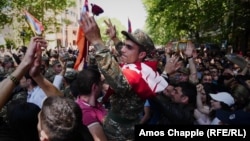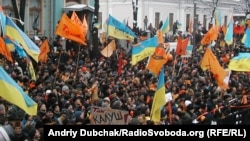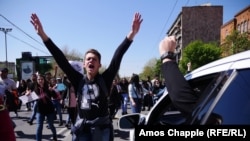Outrage over allegations of political cronyism. Mass protests in the capital. Young people demanding a say in their country's future. A leader's sudden departure from power.
Serbia in 2000? Georgia in 2003? Ukraine in 2004 (or 2014)? Kyrgyzstan in 2005?
No, this is Armenia in 2018.
With Yerevan convulsing in exuberance and nervousness over Prime Minister Serzh Sarkisian's abrupt decision to step down, observers and analysts are watching the culmination of 11 days of protests for parallels to what Moscow has derisively in the past so-called "color revolutions."
For Moscow the term is, at best, merely dirty words, describing mass demonstrations that topple incumbent political forces.
At worst, it is a strategic weapon allegedly used by the West to foment regime change, not only in the former Soviet Union, but also the Middle East, leading to instability and an undermining of Russian interests.
So far, there are plenty of echoes between what happened in Armenia over the past week and the Rose Revolution in Georgia in 2003, or the Orange Revolution in Ukraine in 2004, or the Euromaidan demonstrations that led to a revolution in Ukraine in 2014.
In his victorious speech given hours after Sarkisian announced his resignation, opposition protest leader Nikol Pashinian explicitly used the language of revolution, but also pushed back against insinuations of foreign interference.
"It's a pure Armenian velvet revolution," the 42-year-old Pashinian told a crowd of supporters, referring to the Velvet Revolution of 1989 that ended decades of Communist Party control in Czechoslovakia.
Armenia has been convulsed by upheaval in the past, most recently in 2015 during what some called #ElectricYerevan, a series of demonstrations against a stiff hike in power tariffs. Those featured young people as well and sporadic violence from riot police. They ended with the government backing down on an immediate tariff increase.
This time, the protests have also featured a predominantly young crowd, but the demonstrations also swelled into the tens of thousands -- among the largest public outpourings since Armenia's independence from the Soviet Union in 1991.
Richard Kauzlarich, a former U.S. ambassador to neighboring Azerbaijan, says the size of the crowds, along with the lack of violence and the presence of soldiers appearing alongside some demonstrators, set these protests apart from previous ones.
"It's really hard to say just yet, looking at it, whether this is indeed a colored revolution," Kauzlarich says. "I would certainly like to the think the movie has ended this morning, with the will of the people being accepted."
"[But] politics in Armenia doesn't always take place on the visible side of the curtain, there's a lot going on behind the scenes that we can't see," he adds.
A Real Revolution?
Simon Saradzhyan, director of the Russia Matters project at Harvard University's Belfer Center for Science and International Affairs, points out that despite his resignation as prime minister, Sarkisian's political party -- the Republican Party of Armenia (HHK) -- maintains its dominance of parliament.
And Sarkisian remains the head of the HHK.
"This does not qualify as a revolution, in my opinion, but if they try to nominate someone whom the general public doesn't like, and the protests continued, then you could say this would be a revolutionary moment," Saradzhyan says.
Armenia remains a poor country, hobbled by severe trade restrictions from Turkey along Armenia's western border imposed in solidarity with Azerbaijan, which sits to Armenia's east.
Its economy is hugely dependent on remissions from its far-flung diaspora in Russia, Western Europe, and the United States, as well as trade with Russia, more broadly. Iran is also an important trading partner.
"Armenia [is] a classic case of a society so unfree [that] the public was alienated and angry, but free enough to let them protest. Not Russia," Thomas de Waal, a longtime Caucasus watcher with Carnegie Europe and author of the book Black Garden: Armenia And Azerbaijan Through Peace And War, wrote in a series of tweets.
"Note also there is no systemic opposition in Armenia. This is a young urban crowd [of people] who don't belong to [political] parties, are barely represented in parliament," he wrote.
'Russia Is Always With You'
Several experts contrasted Sarkisian's apparently voluntary decision to resign with events in Ukraine in 2014, when then-President Viktor Yanukovych resisted not weeks, but months, of mass protests, before violent clashes in the capital finally led him to flee. The Kremlin refers to those events as a military coup.
In addition to Ukraine and Georgia, Kyrgyzstan also experienced upheaval in 2005 that drove longtime leader Askar Akaev from power. Those events, plus Middle East uprisings that came to be known as the Arab Spring, led Russian military strategists to develop a theory that the mass protests were a form of warfare engineered by Washington and NATO.
The chairman of Russia's military General Staff was the leading proponent of this theory, which gained public attention about a year before the 2014 Euromaidan protests in Ukraine.
Russian President Vladimir Putin himself accused then-U.S. Secretary of State Hillary Clinton of being behind mass protests in Moscow in 2011 and 2013 that followed parliamentary and later presidential elections; both of which were criticized as deeply flawed and undemocratic.
Alex Melikishvili, principal research analyst for Europe/CIS forecasting at IHS Markit Country Risk, says he was also reluctant to label the Armenian upheaval as a "color revolution" since Pashinian shunned the use of that term and tried to emphasize the "genuinely grassroots and internal character" of the protests.
"This, in part, can be explained by the understandable fear that even the slightest hint of some sort of foreign involvement would invite unwanted attention from the Russian authorities, who have a lot at stake in Armenia for obvious geopolitical reasons," he tells RFE/RL.
At least for now, that observation has been borne out by Moscow's initial reaction in the hours after Sarkisian's resignation, which was either viewed as subdued or largely supportive of the events in Armenia.
"A people that has the ability to maintain respect for one another and not divide even in the most difficult moments in its history -- despite categorical differences -- is a mighty people," Foreign Ministry spokeswoman Maria Zakharova wrote on Facebook. "Armenia, Russia is always with you," she added.
Senior Russian lawmakers also backed Sarkisian's decision to step down.
"Russia has been a strategic ally to Armenia over the course of many years, and there is nothing to suggest that this would change," Leonid Slutsky, the chairman of the Foreign Affairs Committee in Russia's lower house of parliament, was quoted by Interfax as saying.
Sergei Tsekov, a member of the International Relations Committee in Russia's upper house of parliament, said Armenia "under any government will seek cooperation with Russia." Armenians "understand that Russia is Yerevan's eternal and reliable friend," Tsekov was quoted by the state-run RIA Novosti news agency as saying.
Saradzhyan points out that Sarkisian's temporary successor, Karen Karapetian, used to work for an energy company tied to the Russian natural-gas giant Gazprom. That, he says, likely meant Moscow was less rattled by the upheaval for the moment.
Still other observers say that even though Armenia's foreign policy toward Russia was unlikely to change under Karapetian, the optics of street protests leading to a change in political leadership would remain unnerving to Moscow.















